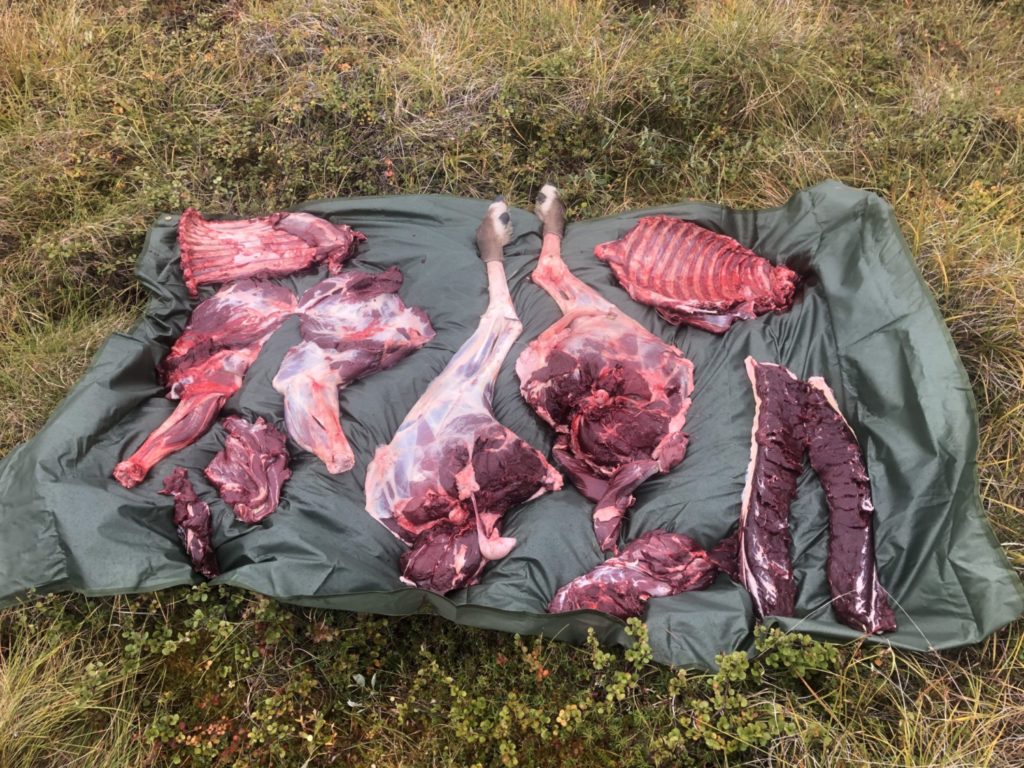After you have killed an animal it is your responsibility to salvage all of the edible meat, in accordance with the Alaska meat salvage regulations which reflect the high value Alaskans place on game meat, ethical hunting and respectful treatment of game animals.
Meat Salvage Requirements
Failure to salvage edible meat is a serious offense and penalties here are stiff. If no attempt is made to salvage meat, the minimum fine is $2,000 and 7 days in jail. The more egregious charge, of wanton waste, carries a maximum penalty of one year in jail and a $10,000 fine.
- You must salvage all of the edible meat for all big game animals except brown/grizzly bear, wolf and wolverine; see the regulations for an exception to this rule for black bears.
- In some units you are also required to leave the meat on the ribs, front quarters and hindquarters until it is brought out of the field. Meat may be de-boned once it has been transported to a state-maintained airport. Do your research prior to your hunt.
- Be aware that Alaska regulations state that the horn, hide, or antlers may be taken out of the field only after the meat is packed out.
- Meat must be transported out of the field in edible condition before or at the same time as the antlers.
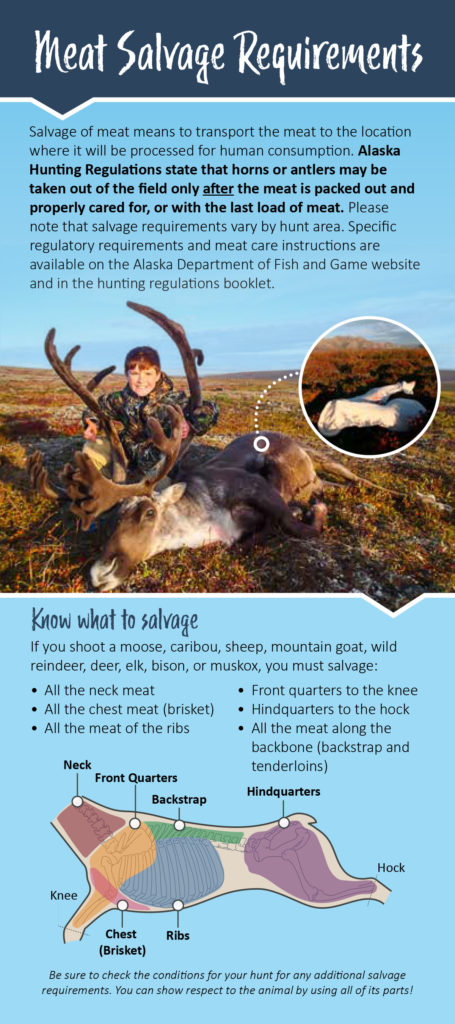
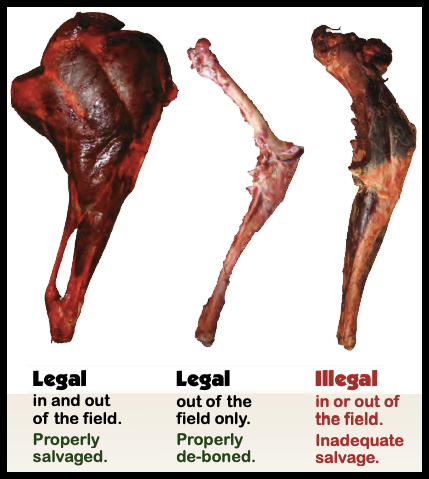
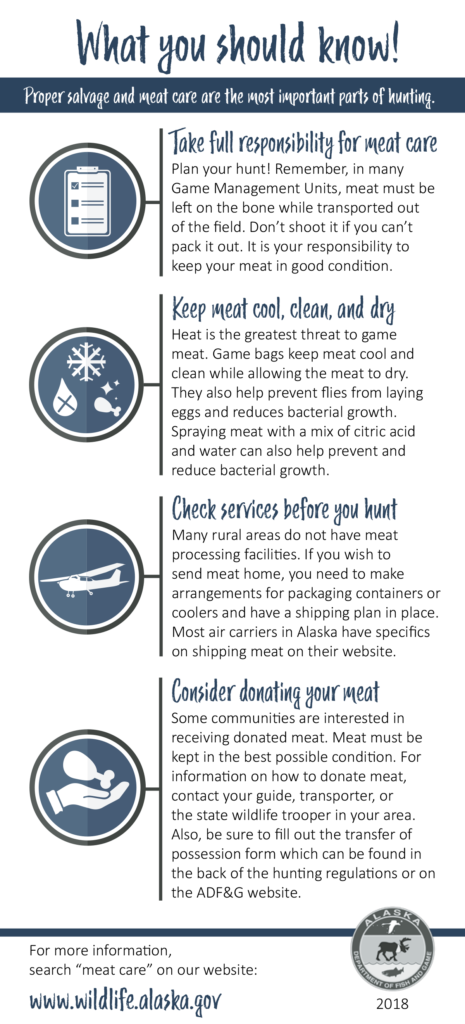
Field Dressing
Hunters should know how to field dress and care for meat before going afield. Some hunters waste a lot of valuable meat because they simply do not know the how to properly field dress game. There are several good methods of field dressing. You will be successful with any method as long as you remember these keys to meat care: Keep the meat cool, clean, and dry.
In the field, you’ll need these basic field dressing tools:
- Sharp knife (or two)
- Bone saw and/or axe
- Knife sharpener
- Game Bags (make sure they are the correct size for the animal you are hunting and are quality)
- Tarp (helps keep meat clean and dry) *You can also use the hide for this if you know how.
- Rope and pulley (for tying off legs, lifting quarters or moving the carcass)
- Latex and/or cut resistant gloves
- Pack Frame or Internal Frame Backpack for transporting meat.
The first thing you should ALWAYS do after killing your animal is validate your harvest ticket or permit.
Skinning your animal.
- To begin skinning, lift the top, hind leg. Start by cutting around the hock (heel/knee).
- Continue cutting down along the inside of the animals leg toward the anus.
- Just before reaching the anus, turn your knife and cut along the side of the genitals, leaving them naturally attached to the meat.
- Continue up the belly along the midline toward the chin.*
- Cut around the hock of the front leg, then down the inside of the leg to the existing cut at the midline.
- Skin the hide back to just beyond the backbone.
- Spread out the hide to make a clean surface for working. The hide can be used in place of a tarp.
- Make sure to keep hair away from the meat since it often carries a pungent odor during the rut that can taint the meat’s flavor.

*Some hunters choose to skin their animal by making the main cut along the mid-line of the back instead of the midline of the stomach. This is actually a good approach as it reduces the risk of puncturing the guts.
Removing the Meat
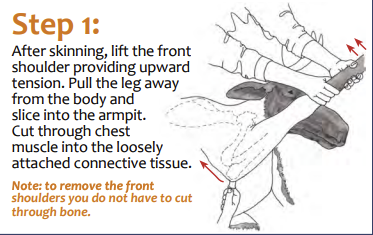
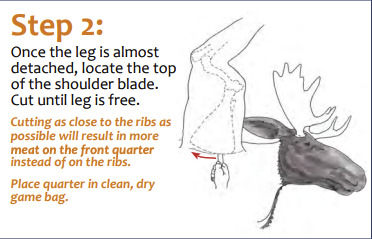
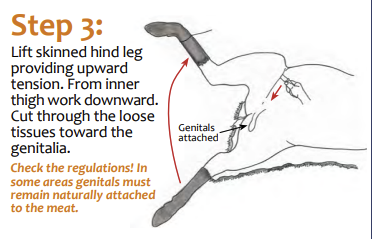

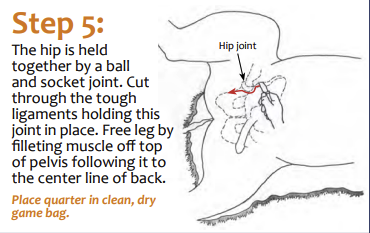
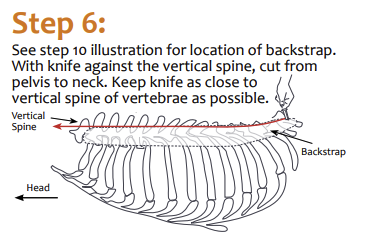
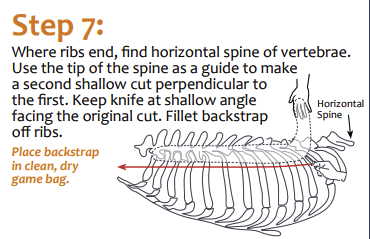
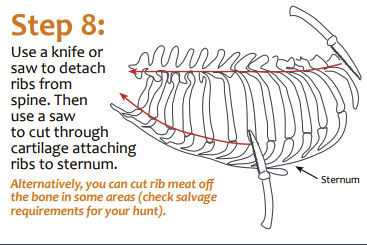
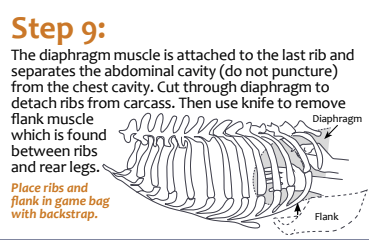
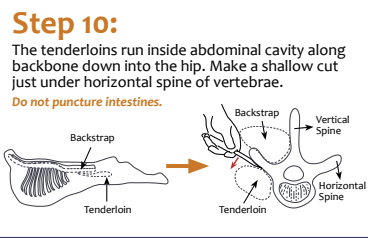
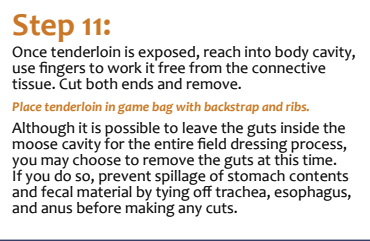
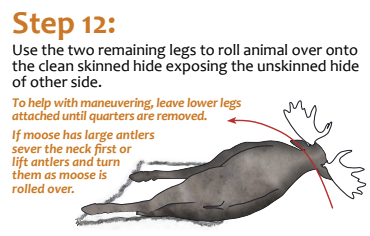

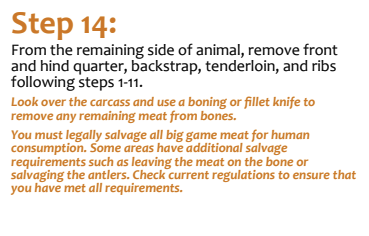
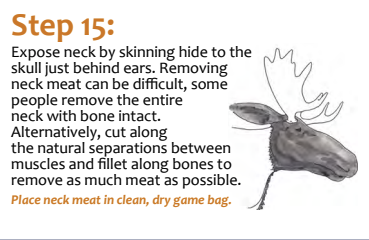
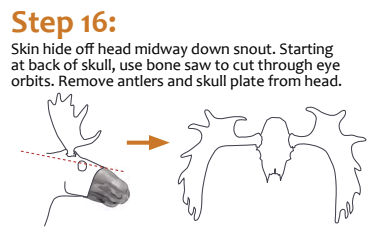
Keep the Meat Cool, Clean and Dry
Make sure the meat is clean.
Rinse off any rumen, bile, or urine that gets on the meat. Also keep hair, leaves and tundra off of it as much as possible.
Heat is the greatest threat to game meat.
The microorganisms that spoil meat multiply more rapidly in warm temperatures. To get the meat cool, remove the hide as quickly as possible and get the meat away from internal organs. The warmer the weather, the more urgent this becomes. Be sure to bring enough ropes and tarps to keep the meat out of the sun at all times. It may be appropriate on some hunts to schedule a mid-hunt check by an air taxi to pick up meat.
Meat that spoils the quickest will be around the hip joint in the ham (rear leg).
In weather over 60 degrees, it may be necessary to actually place the meat in cool water for 30 to 45 minutes to reduce the heat. A nearby creek, river, or lake will do the job. This is about the only time that game meat should be put into a plastic bag.
As soon as possible after cooling, remove the meat from the plastic (if used), thoroughly dry the meat, and put it into cotton game bags. Resembling coarse pillow cases, good bags allow air to circulate to the meat but are tough enough to hold heavy loads. Avoid the bags that look like cheesecloth; they rip easily and allow flies to get on the meat to lay eggs. Bag all of your meat before you take your first load back to camp.
Back at camp hang the bagged meat off the ground to help keep the meat clean and cool.
Hang it in a tree, on a rack, or in a small stand of alders. Your hanging area should be close enough to your camp that you can see it, but not so close that a bear could cause problems.
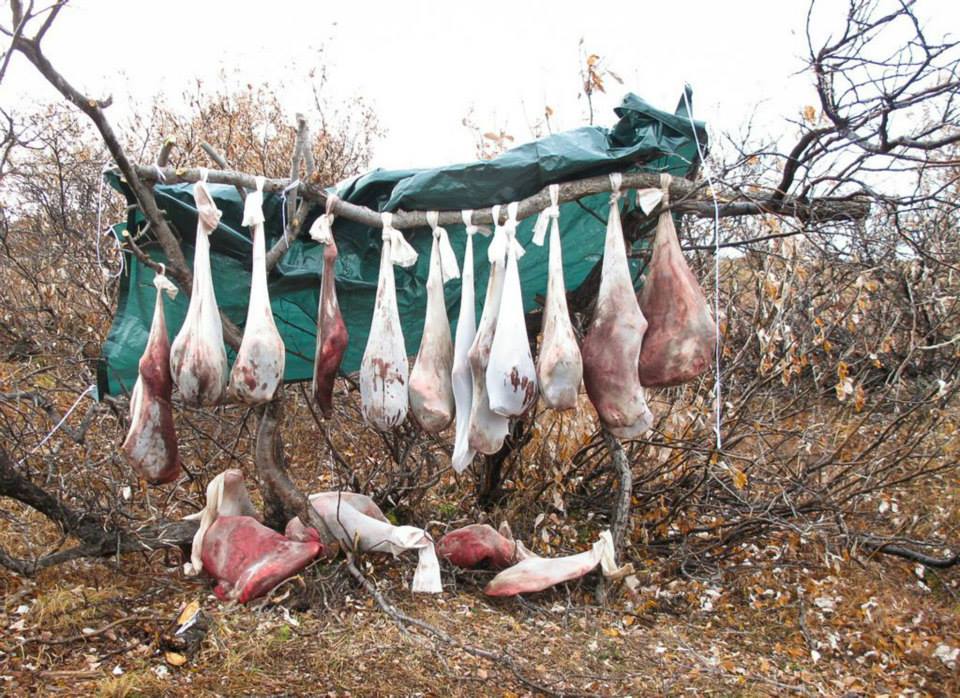
Once all the meat is hung, remove the meat bags and spray the meat with a citric acid/water mixture if you have some.
The meat should be sprayed until the mixture begins to run off the meat. About two ounces of citric acid for each quart of water will do the job.
Food grade citric acid can be purchased online and at most pharmacies or feed stores. The citric acid will slow down bacteria growth that spoils meat, and it creates a dark “crust” on the outside of the meat that makes it harder for flies to lay their eggs on the meat. Don’t worry about the citric acid mixture getting the meat too wet. The mixture will dry quickly. Once meat is dry, reinsert it into meat bags.
A tarp should be loosely placed over the meat pole to keep rain off the meat bags.
The meat should be checked daily. The loose pieces of meat in the “hamburger” bag should be moved around each day to make sure they all keep cool and dry. Do not store game meat in plastic bags.
If you are on a river float hunt, it is very difficult to keep the meat dry and cool when it is stacked inside the raft.
Devise a rack to keep the meat off the wet floor. Then remove the meat from the raft every night before you make camp and hang it where it can stay cool and dry, with air circulating around it.
Meat will usually keep for a week or more in the field if kept cool and dry.
One popular method for transporting meat is to pack some of your gear in “wet-lock” boxes and then pack meat in them when you are ready to leave.

Getting Picked Up
When it is time to get picked up, DO NOT pile gear/meat/antlers on the runway area. Keep it neatly assembled off to the side where it was unloaded.
Once you get back to the hangar, you will need to butcher your meat for shipment back home or for donation to town.

